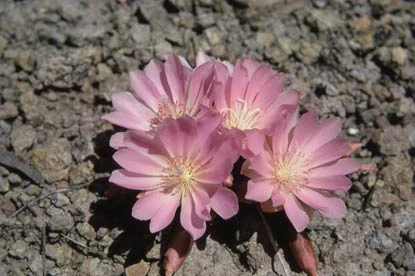
NPS photo Bitterroot Ninety years earlier, the Expedition first encountered the plant. At that time, in late August of 1805, instead of admiring the flower, Meriwether Lewis saw and tasted the root. Writing in his journal, Lewis described the root as “cilindric and as white as snow throughout, except some small parts of the hard black rind which they had not seperated in the preperation… [the roots] became perfectly soft by boiling, but had a very bitter taste, which was naucious to my pallate, and [I] transfered them to the Indians who had eat them heartily.” Given this description, Lewis might vigorously endorse the common name of this plant: bitterroot. Although Lewis little relished it, the Shoshone, his hosts in August of 1805, thoroughly enjoyed the boiled root. Each year, before the plant flowered, American Indians collected this important food source, which grows from California to Montana, and from British Columbia to Arizona. Along the Trail, the Northern Shoshone, Flathead, and Nez Perce harvested the bitterroot. Many other tribes throughout the bitterroot’s range also collected and traded the highly valued plant. Despite the powerful effect it had on Lewis’s tastebuds, the bitterroot received scant attention in the Expedition journals. Nearly a year after his first taste of bitterroot, Lewis again encountered the plant. In early July of 1806, at Traveler’s Rest in western Montana, Lewis collected a bitterroot plant, and three other species, to add to the collection he would present to President Jefferson. His only record of this encounter with the bitterroot notes that, “I found several other uncommon plants specemines of which I preserved.” Upon the Expedition’s return, the bitterroot became one of 134 plant specimens presented to Frederick Pursh for analysis and identification. Pursh gave the plant its scientific name, Lewisia rediviva, commemorating Meriwether Lewis’s role in bringing the plant to the attention of western science and describing the plant’s apparent ability to return from the dead. In his Flora Americae Septentrionalis, Pursh noted that the specimen Lewis carried from Montana, deprived of water and soil for several years, had been planted. Although no flower blossomed, Lewis's bitterroot had “vegetated for more than one year.” Rediviva, a Latin word, translates to “brought back to life.” More information on the bitterroot is available in the following books and websites. Books Lewis and Clark’s Mountain Wilds: A Site Guide to the Plants and Animals They Encountered in the Bitterroots. Written by Sharon Anelia Ritter and published by the University of Idaho Press. A Trailside Reference: Rocky Mountain Natural History (Grand Teton to Jasper). Written by Daniel Mathews and published by Raven Editions.
|
Last updated: July 21, 2021
